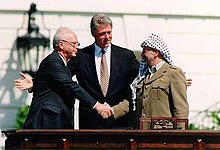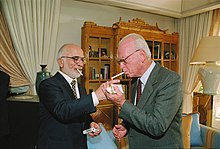Middle East Peace Process

The Middle East Peace Process describes diplomatic efforts to achieve a peaceful settlement of the Middle East conflict , in particular the initiatives to end the conflict between Israel and the Palestinians with the mediation of the United States and the Middle East Quartet . However, due to the alleged unsolvability of the conflict or the lack of political will to implement a peaceful solution, the term is sometimes considered a mere political catchphrase among critics .
Conceptual history and criticism
According to William B. Quandt, the concept of the peace process became established in the course of the 1970s among American diplomats to denote efforts to find a peaceful solution to the Israeli-Arab conflict that had previously been largely armed with negotiations. However, it has been questioned whether individual events and diplomatic successes actually justified the use of such a teleological term, especially under the impression of repeated violence between the conflicting parties. Irving Kristol saw the term in 1988 as a mere euphemism for a cold war; Edward Said even saw the use of the term as "negligent murder of language".
Diplomatic initiatives to resolve the conflict

Even before the first Arab-Israeli war and the Israeli declaration of independence , there were attempts to settle the conflicts between Zionists and Arabs diplomatically, for example through the Faisal-Weizmann Agreement of 1919. In the reign of Moshe Sharet , further serious efforts to compromise with the Arabs followed Israel’s Arab neighbors, which, however , had to be largely suspended as a result of the Lawon affair and which were not continued under David Ben Gurion .
Since the 1970s, the US Secretary of State Henry Kissinger tried harder to find a diplomatic solution as a result of the Yom Kippur War . He established the role of the United States as the main mediator in the Middle East conflict. The 1973 Middle East Conference in Geneva was followed by the first interim agreements between Israel and Egypt and between Israel and Syria.
The Israeli-Egyptian peace treaty of 1979 and the Israeli-Jordanian peace treaty of 1994 can be seen as the first concrete results of efforts to normalize relations between Israel and the Arab states. So far, however, there has been no recognition of Israel's right to exist by other Arab states. The Arab peace initiative of 2002 officially offered the prospect of establishing diplomatic relations for the first time, but was rejected by the Israeli leadership because of its conditions on the refugee issue and the borderline.
The first direct negotiations between Israel and the Palestinians mediated by Norway led to the Oslo peace process in the 1990s . With the roadmap , the two-state solution became the declared goal of peace efforts in the Middle East. For a long time it was also the model favored by the majority of the Israeli and Palestinian population for ending the conflict. Alternative proposals such as the binational solution find less support in comparison. As a result, it can often be heard that everyone knows the solution to the conflict, but no one knows the path that leads to it.
In July 2013, on the initiative of US Secretary of State John Kerry, new direct negotiations between Israelis and Palestinians began on a comprehensive and final contractual solution to the conflict, which ended in April 2014 with no results.
Attempts to resolve conflicts outside of negotiations

Despite repeated attempts over many years to end the Middle East conflict through indirect and direct negotiations, the conflict remains unsolved. For this reason, there have been and still are various attempts by the conflicting parties to influence the dynamics of the peace process outside of the negotiation path and, if necessary, to enforce their own interests unilaterally or against the will of the opponent. At the same time, there are unofficial and civil grassroots movements , initiatives and campaigns that want to strengthen or revitalize the peace process on other levels, such as the Geneva Initiative of 2003.
Economic ways out of the conflict
Joint economic development programs can advance the peace process in a number of ways. They strengthen day-to-day cooperation between Israeli and Palestinian institutions and reduce the likelihood of terrorist attacks and other forms of politically motivated violence. Above all, however, the establishment of stable economic conditions is essential for successful nation building and thus a prerequisite for the fact that with a Palestinian statehood an end to the conflict actually comes closer.
One example of this is the joint development plan for the Arava basin, originally initiated through Japanese mediation . In 2013, Israel, Jordan and the Palestinian Authority agreed a contract on a long-term construction project, as part of which water from the Gulf of Aqaba is to be made usable via desalination plants and pipelines for drinking water supply and to slow down the drying out of the Dead Sea and to create numerous jobs.
It has also been pointed out that both Israel and the Palestinians and the Arab states could profit significantly from an end to the conflict economically. The financial losses to the economies in the region since the 1991 Madrid Peace Conference alone are estimated at over 12 trillion dollars.
Unilateral options
Due to the considerable asymmetry of the conflict, unilateral options for conflict resolution are primarily available to Israel as the politically, economically and militarily superior party to the conflict. Mention should be made here of the Israeli decoupling plan, adopted in 2004 and implemented in 2005 , which led to the evacuation of the Gaza Strip, and the subsequent convergence plan, which was never implemented in practice. For their part, in 2011 the Palestinians tried to unilaterally achieve recognition of Palestine as a full member of the United Nations and thus greater recognition of the Palestinian statehood. According to Gidi Grinstein, increased use of such funds can be expected as long as the structural deficiencies in the negotiation process are not remedied.
Perspectives of the Peace Process
Realpolitical developments are increasingly opposed to a two-state solution. The number of Israeli citizens living in settlements in the West Bank has risen further, and an Israeli annexation of the Jordan Valley is being discussed again. The factual political split in the Palestinian leadership as a result of the ongoing Fatah-Hamas conflict makes efforts to find a peaceful solution to the conflict even more difficult, as does the instability of many neighboring Arab states as a result of the effects of the Arab Spring .
Recent polls show that fewer and fewer people, both Israelis and Palestinians, believe in the two-state solution.
In the opinion of Ilan Peleg and Paul Scham, however, “ironically and tragically” outbreaks of violence in particular can revitalize the peace process, as they shift the focus away from conflict management and towards conflict resolution.
literature
- Oren Barak: The Failure of the Israeli-Palestinian Peace Process, 1993-2000. In: Journal of Peace Research 42/6, 2005, pp. 719-736.
- Martin Beck: Peace Process in the Middle East. Rationality, Cooperation and Political Rent in the Middle East. Westdeutscher Verlag, Wiesbaden, 2002, ISBN 3-531-13724-7 .
- Laura Zittrain Eisenberg, Neil Caplan: Negotiating Arab-Israeli Peace. Patterns, Problems, Possibilities. 2nd Edition. Indiana University Press, Bloomington, 2010, ISBN 978-0-253-22212-1 .
- Daniel C. Kurtzer et al .: The Peace Puzzle. America's Quest for Arab-Israeli Peace, 1989-2011. Cornell Press, Ithaca, 2012, ISBN 978-0-8014-5147-8 .
- Ilan Peleg, Paul Scham: Historical Breakthroughs in Arab-Israeli Negotiations. Lessons for the future . In: The Middle East Journal 64/2, 2010, pp. 215-233.
- Avi Primor : What is the future of the Middle East Peace Process? In: From Politics and Contemporary History . Year 2001, No. 13-14 , 2001 ( online ).
- Saadia Touval: The Peace Brokers. Mediators in the Arab-Israeli Conflict, 1948-1979. Princeton University Press, Princeton, 1982, ISBN 978-0-691-10138-5 .
- William B. Quandt: Peace Process. American Diplomacy and the Arab-Israeli Conflict Since 1967 , Third Edition. Washington, Brookings, 2005, ISBN 978-0-520-24631-7 .
- William B. Quandt: On the Peace Process in the Middle East . In: Daedalus 135/2, 2006, pp. 133-135.
Web links
- History of the Middle East Peace Process on the website of the Federal Foreign Office
Individual evidence
- ^ William B. Quandt: Peace Process. American Diplomacy and the Arab-Israeli Conflict Since 1967 , 2005, p. 1.
- ^ Laura Zittrain Eisenberg, Neil Caplan: Negotiating Arab-Israeli Peace. Patterns, Problems, Possibilities , 2010, pp. 253f.
- ^ Alan Dowty: Israel / Palestine . 3. Edition. Polity, Cambridge, 2012, pp. 177ff.
- ↑ Adiv Sterman: Poll: Most Israelis, Palestinians support two-state solution , The Times of Israel, 31 December 2013.
- ↑ Ilan Peleg, Paul Scham: Historical Breakthroughs in Arab-Israeli Negotiations. Lessons for the Future , 2010, p. 223.
- ↑ Michael R. Gordon, Jodi Rudoren: Kerry Achieves Deal to Revive Mideast Talks , The New York Times, July 19, 2013
- ↑ Kerry in Israel: Peace talks not an issue. In: news.orf.at. November 24, 2015, accessed November 2, 2018 .
- ^ A. Robert Abboud, Newton N. Minow: Advancing Peace in the Middle East: The Economic Path Out of Conflict . In: Foreign Affairs , September / October 2002.
- ↑ Jennifer L. Schenker: A Mideast Valley of Peace , Bloomberg Businessweek, March 28, 2008.
- ↑ Christian Böhme, Dagmar Dehmer: A Pipeline for Peace , Der Tagesspiegel, December 11, 2013.
- ^ Shlomo Swirski: The Cost of Occupation. The Burden of the Israeli-Palestinian Conflict 2012 Report. (PDF; 4.5 MB) Adva-Center , accessed on July 8, 2016 .
- ↑ Sundeep Waslekar, Ilmas Futehally: Cost of Conflict in the Middle East . Strategic Forsight, 2009, ISBN 978-81-88262-12-0 , pp. 4-5.
- ^ Gidi Grinstein: The Return of Unilateralism , Ynetnews, March 27, 2007.
- ↑ Harriet Sherwood: Israeli ministers back Jordan Valley annexation ahead of John Kerry visit , The Guardian, December 31, 2013.
-
↑ https://www.israelnetz.com/gesellschaft-kultur/gesellschaft/2017/08/02/zwei-staat-loesung-verliert-bei-israelis-an-befigung/
http://www.israelheute.com/Nachrichten /Artikel/tabid/179/nid/32997/Default.aspx - ↑ Ilan Peleg, Paul Scham: Historical Breakthroughs in Arab-Israeli Negotiations. Lessons for the Future , 2010, p. 226f.